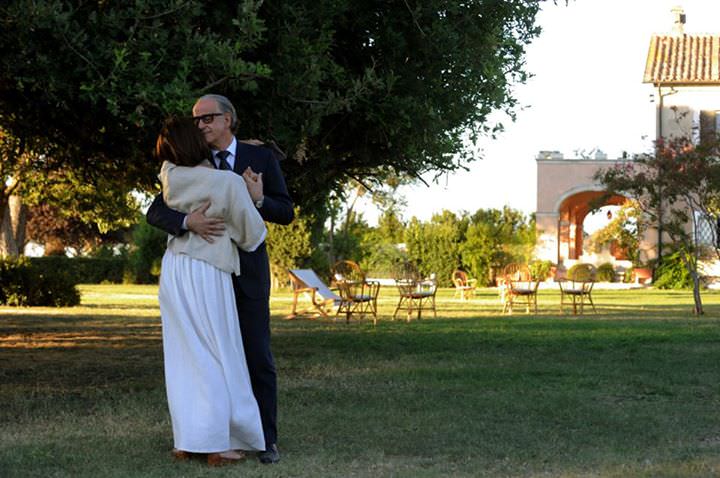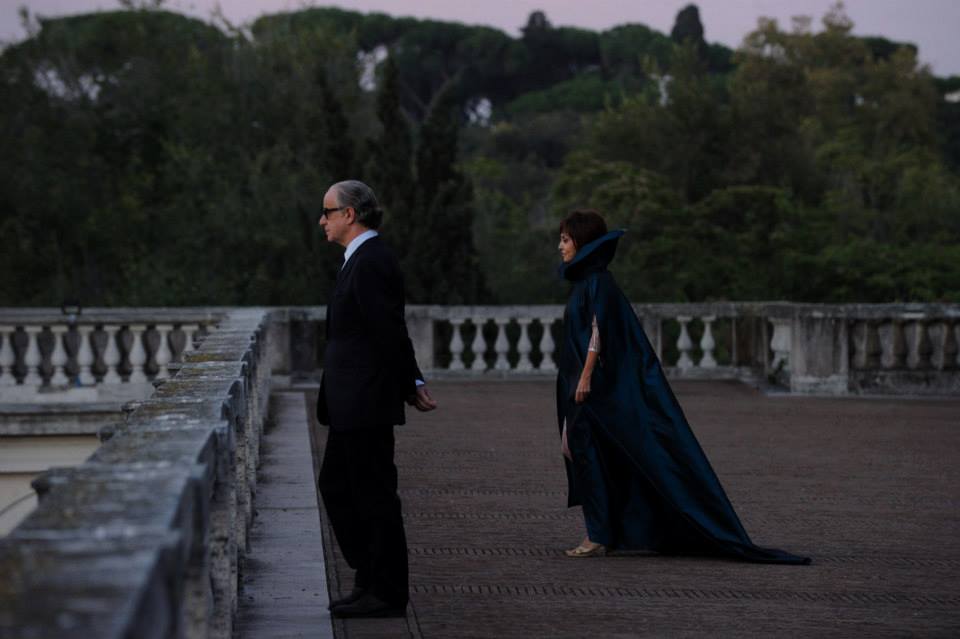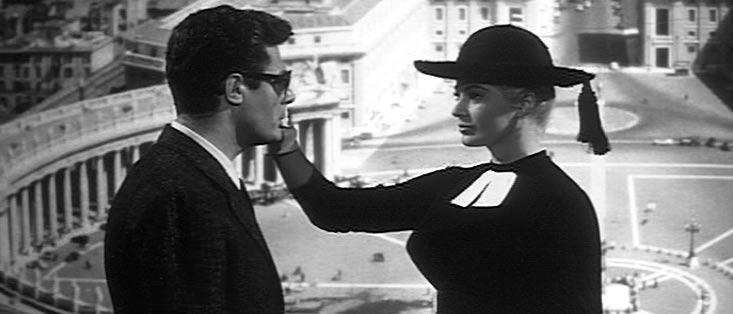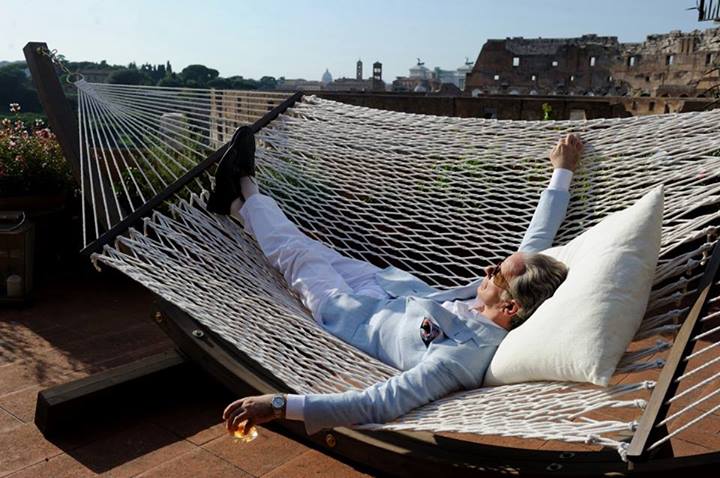If the character Marcello in Federico Fellini’s La Dolce Vita—played unforgettably by Marcello Mastroianni—had spent another four decades flitting about the high life of Rome he might have turned into someone like Jep Gambardella, the protagonist of Italian film director Paolo Sorrentino’s La Grande Bellezza (The Great Beauty).
A self-conscious twenty-first century version of the Fellini classic, La Grande Bellezza is a visual feast, one of the relatively few films that takes full advantage of the extraordinary, almost hallucinatory beauty of Rome. La Dolce Vita was filmed in black and white and so Sorrentino uses extremely lively, rich, exaggerated color cinematography to make Rome even larger-than-life than it is: its extravagant baroque fountains and gardens and ancient ruins pop out of the screen in a pageant of saturated hues. The overripe city stands in stark contrast to the dull, futile, and empty life of its main characters—the frenetic partying, the not-so-hidden desperation and the endless “blah, blah, blah” of their conversation (as Sorrentino characterizes it).
Jep Gambardella is a novelist (originally from Naples) and member of Roman society who wrote a highly acclaimed early novel, The Human Apparatus, but has published nothing of note in forty years. He contributes occasional culture pieces to an unnamed newspaper. His inability or lack of interest in writing reflects the impotence and disenchantment of his world. At various points during the film, different characters ask Jep why he has never written another book. His evolving answers are the closest the film will come to a plot.
Early on in the film, he responds that writing required time and calm and that he wasted too much time going to parties. Later, in the midst of yet another party, he says: “Look at these people, this wildlife. This is my life and it’s nothing. Flaubert wanted to write a book about nothing; he didn’t succeed. So, how could I do it?”
The opening of La Dolce Vita showed a giant statue of Christ being flown across the skies of Rome by helicopter, with Marcello and fellow journalists following in a second helicopter and trying to communicate by gesture with girls sunbathing on the roofs of the city’s new high-rise buildings as they pass by. Fellini appeared to send a clear message: that his film was describing the uneasy and deeply strange transition of a traditional, rural, Catholic society into the wild and amoral world of the “economic miracle” of the 1960s. By contrast, La Grande Bellezza opens with a choir singing at the “Fontanone,” the Fontana dell’Acqua Paola built by Pope Paul V on the Janiculum hill; we see a Japanese tourist faint while photographing the monument. We never return to the scene or find out what happened to the fainting man: An excess of summer heat? Or a sudden bout of Stendhal Syndrome (the malady that causes some tourists to become disoriented from taking in so much beauty in a concentrated span)?
This deliberate refusal to build a rational and coherent story is a signature move of Sorrentino’s, a tip-off that we are not in a world that lends itself to conventional narrative. He seems to be showing us a Rome whose population has succumbed to a random and increasingly meaningless existence. At the very end of the film, as Jep appears to have hit bottom, he says:
I was looking for “La Grande Bellezza” and I didn’t find it…This is how it always ends, with death. But first there was life, hidden beneath the blah, blah, blah. It is all settled beneath the chitter chatter of the noise, the silence and the emotion and the fear, the haggard, inconstant beauty and then the wretched squalor and miserable humanity…There, let this novel begin. After all, it’s just a trick. Yes, it’s just a trick.
Sorrentino is a young filmmaker who has developed a highly stylized, neo-baroque aesthetic while delving into contemporary Italian politics—for example, in his 2008 film on former Italian prime minister Giulio Andreotti, Il Divo. It is hard not to see his latest film—which has been short-listed for nomination for an Academy Award for Best Foreign Picture—as an expression of the disorientation and disenchantment of a country that seems to have lost its way and its belief in itself. The Italy of La Dolce Vita was frivolous but vital; it was a society that was both ancient and young, with the energy and silliness of youth. That sense of vitality is decidedly absent from Sorrentino’s film. There is a moment toward the end where Jep is watching another party, whose guests are cavorting around in a kind of conga dance known in Italian as “il trenino” (little train). Jep says “They have the most beautiful trenini here in Rome. They are beautiful because they go nowhere.”
Advertisement
This sense of going nowhere is common in Italy today. The country’s economy has stalled for the past decade and made almost no progress in twenty years. The Italian Republic is in the company of countries like Zimbabwe for the world’s slowest growing economies. “Italy is dead,” an Italian friend told me just the other day, having come from Rome to Paris to do some work. He didn’t like La Grande Bellezza, but he talked like one of its characters. Younger people are leaving in Italy in alarming numbers, seeking opportunities elsewhere after having been educated at the expense of the Italian taxpayer. “There’s no future here,” friends tell me as they inquire about college or graduate school in the US for their children.
While La Grande Bellezza captures something of Italy’s current mood, there are times when the movie’s aimless wandering seems as empty and insubstantial as Jep Gambardella’s world. It is hard to care about a main character whose ambition was, as he tells us, to “not just be part of Rome high life but to be its King, not just to make parties but to have the power to destroy them.” And none of the secondary characters are more than one-dimensional. One of the larger sub-plots is Jep’s relationship with a beautiful forty-year-old stripper, the daughter of an old friend. We follow them around for about half an hour until she disappears from the film. It wasn’t until I watched the movie a second time that I realized that she had died—apparently from some medical complication. I had missed the point of a very brief scene in which we see (what looks like) her father weeping and accepting condolences.
Some Italian viewers have objected that they didn’t recognize themselves in the film’s absurd bacchanalia. At one point, Jep makes a tour of nocturnal Rome with a man who possesses the keys to all the most beautiful palaces of the city. But, interestingly, the places we see in this sequence—the Capitoline Museum and the Borromini colonnade in the Palazzo Spada—are public buildings, not private palaces. In one sense, this is a trivial point: it’s easier to get permission to film in public spaces than in private ones. But it also suggests that Rome’s high life is not quite as high as the movie portrays—and its problems both more banal and more real. I remember meeting a young couple from Rome complaining about how hard life was. Of course, it’s a beautiful city, I said, trying to sound a positive note. They looked at me a bit perplexed. They lived out on the periphery, amid ugly high-rises, with poor public transportation and snarling traffic jams; they rarely came into the city center where all the beautiful monuments are. They inhabited a different Rome from the one I knew and the one Sorrentino shows.
At another point, Jep asks a woman he is about to sleep with what she does for a living. “I’m rich,” she says. “Nice job,” he replies. Indeed, hardly anyone in La Grande Bellezza—with the exception of a stripper and a toy salesman— seems to work. Jep lives in an apartment with an immense terrace overlooking the Colosseum. (As a former Rome resident, I found myself asking: how does a guy with one book and who seems to write only occasionally afford that apartment?) One would never know watching La Grande Bellezza that Italians are among the hardest working people in Europe, often working extra jobs and putting in an estimated 1752 hours a year—several hundred more than their wealthier Northern European counterparts and about as much as their overworked American cousins. That they are working so hard but still in a trenino going nowhere is what makes this moment a genuine tragedy.
Paolo Sorrentino’s La Grande Bellezza (The Great Beauty) is now in general release in the United States.






